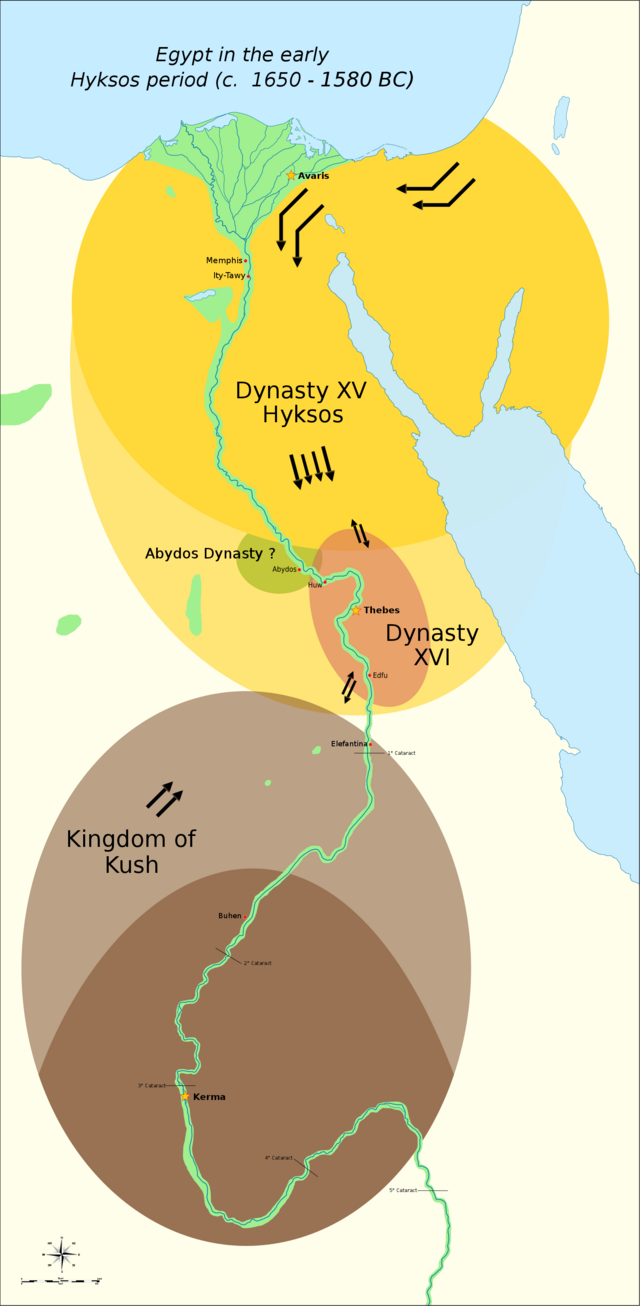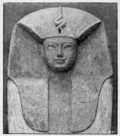Top Qs
Timeline
Chat
Perspective
Seventeenth Dynasty of Egypt
Third Dynasty of the Ancient Egyptian Second Intermediate Period From Wikipedia, the free encyclopedia
Remove ads
The Seventeenth Dynasty of Egypt (notated Dynasty XVII, alternatively 17th Dynasty or Dynasty 17) was a dynasty of pharaohs that ruled in Upper Egypt during the late Second Intermediate Period, approximately from 1580 to 1550 BC. Its mainly Theban rulers are contemporary with the Hyksos of the Fifteenth Dynasty and succeed the Sixteenth Dynasty, which was also based in Thebes. The chronology of the 17th dynasty is very uncertain and the king lists provide little help.[1]

In March 2012, French archeologists examining a limestone door in the Precinct of Amun-Re at Karnak discovered hieroglyphs with the name Senakhtenre, the first evidence of this king dating to his lifetime.[2]
The last two kings of the dynasty opposed the Hyksos rule over Egypt and initiated a war that would rid Egypt of the Hyksos kings and began a period of unified rule, the New Kingdom of Egypt.[1]
Kamose, the second son of Seqenenre Tao and last king of the Seventeenth Dynasty, was the brother of Ahmose I, the first king of the Eighteenth Dynasty.[3]
Some mainstream scholars have suggested that the Seventeenth dynasty of Egypt had Nubian ancestry due to the expanded presence of Nubians in Egypt during that time period and the craniofacial evidence from X-ray examination of Seqenenre Tao who displayed strong affinities with contemporary Nubians. Donald Redford explicitly argues that Egyptians "entered into the service of the king of Kush" between seventeenth and sixteenth centuries BC, citing historical texts along with archaeological evidence that showed an increased Nubian presence from the third Cataract on the Nile as far north as Deir Rifeh. Redford summarises that a shared "community of interest" existed which coincided with the influx of Nubian pottery and weapons in Upper Egypt.[4][5][6] There is no conclusive evidence that the founder of the dynasty, Rahotep, was of Nubian origin however and the dynasty is recognized as a native Egyptian dynasty by many scholars.[7][8][9][10][11][12][13][14][15][16][17]
Remove ads
Pharaohs of the 17th Dynasty
The Pharaohs of the 17th Dynasty ruled for approximately 30 years. Known rulers of the 17th Dynasty are as follows:[18]
Finally, king Nebmaatre may have been a ruler of the early 17th Dynasty.[19]
Remove ads
Pharaonic Family tree
| Nubemhat | |||||||||||||||||||||||||||||||||||
| Nubkhaes II | |||||||||||||||||||||||||||||||||||
| Sobekemsaf | |||||||||||||||||||||||||||||||||||

The War of Liberation Against Hyksos
Summarize
Perspective
While under the Hyksos rule, the kings of the 17th dynasty revived the cult of Osiris, they rebuilt temples, and they established military control over the religious site, Abdju. This was the beginning of their campaign for reunification.[20]
The first wave of attacks launched toward the southern flank was led by King Seqenenre Tao, who was killed in the battle. His son, Kamose, succeeded him as the leader. After securing the southern flank, Kamose took to the North to fight more of the Hyksos. Despite little sustained opposition, he failed to take more land in the north and died suddenly after just 2 years at the throne. He left no sons behind to succeed him and his brother, Ahmose I, came to power at 10 years old.[20]

The nationalists in the North had weakened the Hyksos and could no longer muster a counter-attack. In 1559 BC, led by an old enough to fight Ahmose I, they conquered the city of Memphis. Then, with naval support, conquered Hutwaret. They then followed the Hyksos to Sharuhen, a major center of Hyksos power, and laid siege to it for 3 years. After intimidating the surrounding areas, they had won the war.[20] Being in the middle, the people of Thebes and Upper Egypt were had less influence and were politically "independent". They maintained mostly peaceful relationships with the Nubians and Hyksos, restoring unity to Upper and Lower Egypt.[1] Beginning The New Kingdom of Egypt.[20]
See also
References
External links
Wikiwand - on
Seamless Wikipedia browsing. On steroids.
Remove ads









